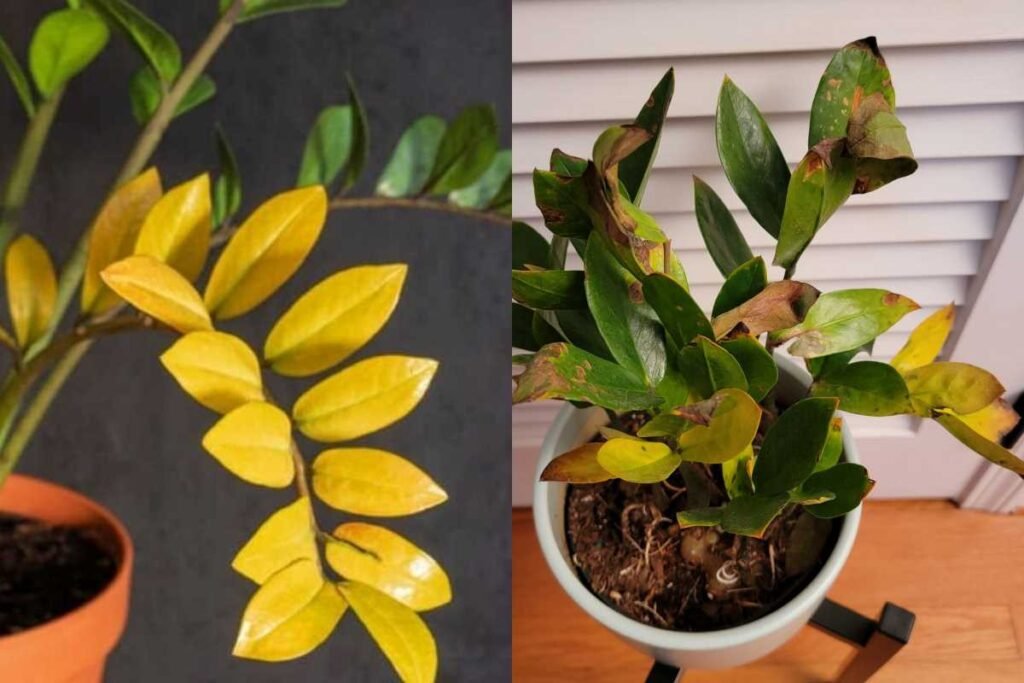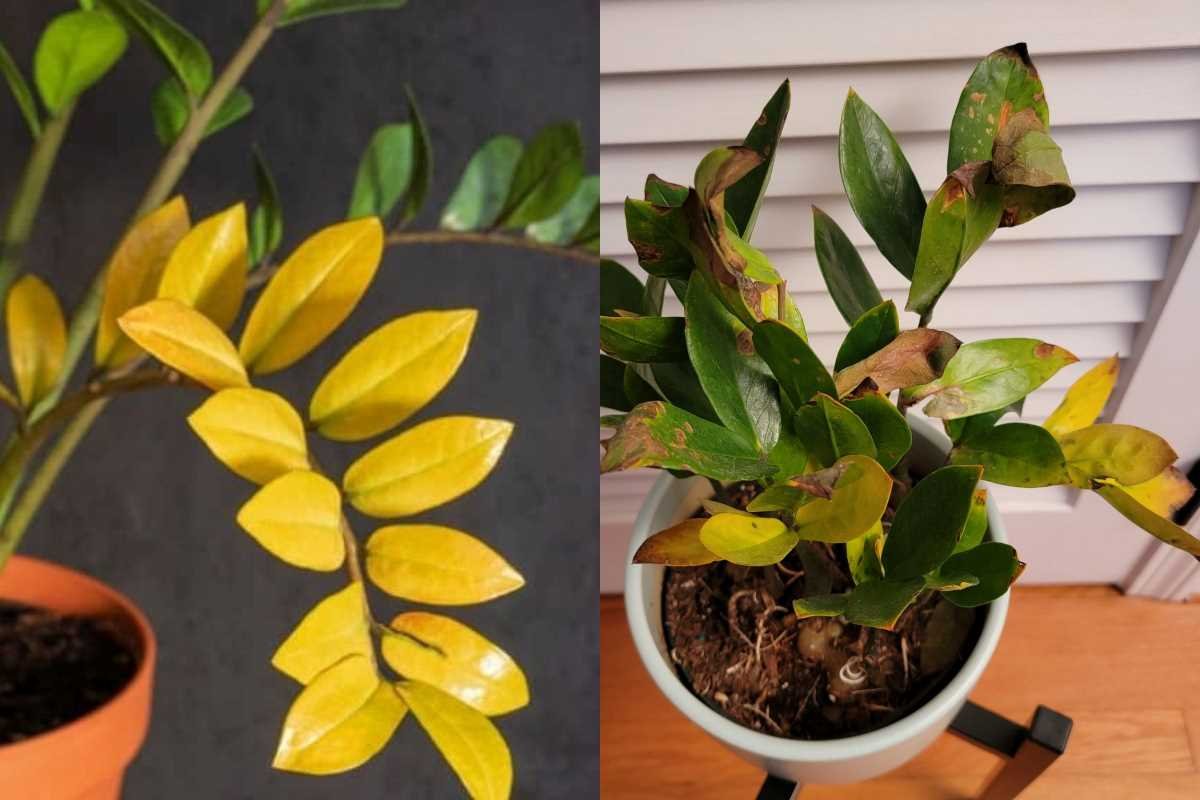Are you a plant lover who is experiencing yellowing leaves on your beloved ZZ Plant, but you know that you’re not overwatering it? Worried about what may be wrong with it?
Don’t fret – in this blog post, we’ll explore the common factors causing the yellowing of ZZ Plant leaves and provide some tips and guidelines for optimal care to help get rid of those pesky yellow leaves.
Read on to learn more!
Why ZZ Plant Leaves Turn Yellow But Not Overwatering?

There are four common factors that can cause the leaves of your ZZ Plant to turn yellow when it’s not overwatering: excessive fertilizer, lack of humidity, too little watering, and low light condition.
1. Excessive fertilizer
If you are regularly fertilizing your ZZ Plant, it is possible that you are giving it too much nitrogen. This excess nitrogen can lead to a condition known as chlorosis, which causes the yellowing and browning of foliage.
To prevent this, be sure to follow the recommended fertilizer dosage listed on your plant’s packaging or consult with your local garden center.
2. Lack of humidity
Another potential cause of yellow leaves on ZZ Plants is a lack of humidity. This can happen if you keep your plant in an excessively dry environment, such as near an air conditioner or heater.
Sometimes, small changes in your plant’s environment can be enough to cause stress and make it susceptible to leaf discoloration. To prevent this, you may need to increase the humidity around your plant by using a humidifier or setting out some pebble trays filled with water.
3. Too little watering
It is also possible that you are not watering your ZZ Plant consistently enough, which can cause the yellowing of the leaves over time. To prevent this problem, make sure to water your plant regularly according to its specific needs: generally speaking, most ZZ Plants will require plenty of water but should be allowed to dry out between waterings.
Read: Underwatered ZZ Plant: Signs, Solutions, FAQs & All.
4. Low light condition
One of the most common causes of yellowing ZZ Plant leaves is low light conditions, as this particular plant requires bright and indirect sunlight to thrive. If your ZZ Plant is not getting enough sunlight, one of its first symptoms will be the appearance of pale or yellowish leaves.
In order to prevent this from happening, be sure to place your ZZ Plant in a bright spot, ideally near a window where it will receive indirect sunlight throughout the day. You can also supplement with artificial grow lights if necessary.
In addition to low light conditions, there are other factors that may lead to yellowing leaves on your ZZ Plant. For example, if you are over-pruning your plant or if it has been affected by pests or disease, you may start to notice yellowing leaves.
Regardless of the cause, there are steps that you can take to help treat and prevent yellowing ZZ Plant leaves. For example, be sure to keep your plant in a well-ventilated area with plenty of indirect sunlight, water it regularly according to its specific needs, and avoid overfeeding or pruning too much.
Conclusion
So, why does your ZZ Plant turn yellow when not overwatering? There are a number of possible factors that can cause yellowing leaves on your ZZ Plant, including excessive fertilizer, lack of humidity, too much watering, or low light conditions.
To treat and prevent this problem, it is important to be aware of these factors and take steps to address them as needed.
Some possible strategies for increasing humidity, keeping your plant in a bright spot with plenty of indirect sunlight, and avoiding overfeeding or pruning too much.
Additionally, you may want to consult with a local garden center or nursery for additional tips and guidance.
Related FAQs:
What causes yellowing ZZ Plant leaves?
There are several possible factors that can cause the leaves of a ZZ Plant to turn yellow, including excessive fertilizer, lack of humidity, too much watering, too little watering, and low light conditions.
To treat and prevent yellowing leaves on your ZZ Plant, it is important to be aware of these factors and take steps to address them as needed.
How can I increase the humidity around my ZZ Plant to prevent yellow leaves?
One possible way to increase humidity around your ZZ Plant is to use a humidifier or set out some pebble trays filled with water.
Another strategy is to move your plant to a location near an air conditioner species good resonate treaty Gods what’s wrong then you’ll have to ask the person who gave you the plant, as they will likely know more specific details about its care and maintenance needs.
Additionally, you may want to consult with a local garden center or nursery for additional tips and guidance.
How can I ensure that my ZZ Plant is getting enough light?
To prevent yellow leaves on your ZZ Plant, it is important to place the plant in a bright spot with plenty of indirect sunlight.
This can be achieved by placing the plant near a window or supplementing it with artificial grow lights if necessary.
Additionally, you may want to experiment with different placement locations in your home or office until you find a setup that is optimal for your plant’s needs.
How often should I fertilize my ZZ Plant to avoid yellow leaves?
ZZ Plants typically require minimal fertilization. To avoid over-fertilization and potential yellowing of leaves, fertilize your ZZ Plant no more than once every 3-6 months during the growing season (spring and summer). Use a balanced, water-soluble fertilizer at half the recommended strength. Always follow the instructions on the fertilizer packaging and avoid fertilizing during the plant’s dormant period in fall and winter.
Can pests cause yellow leaves on a ZZ Plant?
Yes, pests such as spider mites, aphids, and mealybugs can cause yellowing leaves on ZZ Plants. These pests can damage the plant by sucking sap from the leaves, leading to discoloration and stress. Regularly inspect your plant for signs of pests, such as webbing, sticky residue, or visible insects. If pests are detected, treat the plant with insecticidal soap or neem oil, and isolate it from other plants to prevent spreading.
What are the signs of too little watering in a ZZ Plant?
Signs of underwatering in a ZZ Plant include yellowing leaves, dry and crispy leaf tips, and overall wilting. The soil may also appear very dry and may pull away from the edges of the pot. To avoid underwatering, water your ZZ Plant thoroughly when the top inch of soil feels dry to the touch. Allow excess water to drain away and ensure the pot has adequate drainage holes.
How can I improve light conditions for my ZZ Plant indoors?
To improve light conditions for your ZZ Plant indoors, place it near a window with bright, indirect light. North or east-facing windows are ideal. If natural light is insufficient, consider using artificial grow lights, positioning them about 12-18 inches above the plant. Ensure the plant receives about 6-8 hours of light per day. Avoid direct sunlight, which can scorch the leaves.
Is it normal for older leaves on a ZZ Plant to turn yellow?
Yes, it is normal for older leaves on a ZZ Plant to turn yellow and eventually die off as the plant grows. This natural process allows the plant to conserve energy for new growth. Simply trim off the yellowing leaves with clean scissors or pruning shears to maintain the plant’s appearance. Ensure you are not mistaking this natural aging process for a sign of underlying issues like improper care or pest infestation.
How does temperature affect ZZ Plant health and leaf color?
ZZ Plants prefer temperatures between 65-75°F (18-24°C). Exposure to extreme temperatures, either too hot or too cold, can cause stress and lead to yellowing leaves. Keep your ZZ Plant away from drafts, air conditioning vents, and heaters. Maintaining a stable temperature within the preferred range will help ensure your plant remains healthy and vibrant.
What type of soil is best for a ZZ Plant to prevent yellow leaves?
ZZ Plants thrive in well-draining soil. A mix designed for succulents or cacti, which typically contains a combination of potting soil, sand, and perlite, is ideal. Good drainage prevents water from pooling around the roots, reducing the risk of root rot and yellowing leaves. Repot your ZZ Plant every 2-3 years to refresh the soil and provide ample room for growth.
Can moving a ZZ Plant cause its leaves to turn yellow?
Yes, ZZ Plants can experience stress from being moved, which may result in yellow leaves. Changes in light, temperature, or humidity levels can shock the plant. To minimize stress, try to move the plant gradually into its new environment, allowing it to acclimate over a few days. Monitor the plant closely after moving and adjust care as needed to ensure it adapts well to its new location.
How do I know if my ZZ Plant is suffering from nutrient deficiencies?
Nutrient deficiencies in a ZZ Plant can manifest as yellow leaves, stunted growth, and poor overall health. If you suspect a deficiency, consider the following:
- Nitrogen deficiency: Yellowing starts from the older leaves.
- Magnesium deficiency: Yellowing between leaf veins, while the veins remain green. To address nutrient deficiencies, use a balanced, water-soluble fertilizer at half strength and ensure the plant receives appropriate light and water. Soil tests can also help identify specific nutrient imbalances.
By understanding these common issues and implementing proper care techniques, you can keep your ZZ Plant healthy and free from yellow leaves.
Can repotting cause my ZZ Plant leaves to turn yellow?
Yes, repotting can cause stress to your ZZ Plant, potentially leading to yellowing leaves. This can occur if the roots are disturbed, if the new potting soil is not suitable, or if the plant is exposed to different environmental conditions. To minimize repotting stress, ensure you use well-draining soil, gently handle the roots, and keep the plant in a stable environment post-repotting. Water the plant lightly after repotting and avoid fertilizing for a few weeks to allow it to adjust.
What is chlorosis and how does it affect ZZ Plant leaves?
Chlorosis is a condition where leaves produce insufficient chlorophyll, resulting in yellowing. In ZZ Plants, chlorosis can be caused by nutrient deficiencies, especially nitrogen, iron, or magnesium. It can also result from poor drainage, compacted soil, or improper pH levels. To address chlorosis, ensure your ZZ Plant receives balanced nutrition, good drainage, and is planted in slightly acidic to neutral soil (pH 6.0-7.0). You might need to adjust fertilization or amend the soil to correct nutrient imbalances.
How can I tell if my ZZ Plant is suffering from root rot?
Root rot is a serious condition often caused by overwatering, but it can also occur due to poorly draining soil or a lack of aeration. Signs of root rot in a ZZ Plant include yellowing leaves, a mushy stem, and a foul odor from the soil. If you suspect root rot, remove the plant from its pot and inspect the roots. Healthy roots should be firm and white, while rotten roots are brown, mushy, and may break easily. Trim away any affected roots, repot the plant in fresh, well-draining soil, and reduce watering frequency.
Can temperature fluctuations cause yellow leaves on my ZZ Plant?
Yes, temperature fluctuations can stress ZZ Plants, causing their leaves to yellow. ZZ Plants prefer stable temperatures between 65-75°F (18-24°C). Exposure to sudden temperature drops or spikes, such as drafts from windows or doors, can lead to leaf discoloration. To prevent this, place your ZZ Plant in a location where it will not be exposed to drafts, direct heat sources, or cold air vents.
How can improper pruning affect my ZZ Plant?
Improper pruning can stress your ZZ Plant and lead to yellowing leaves. Pruning too much or cutting too close to the base can damage the plant. Always use clean, sharp scissors or pruning shears and make cuts above a leaf node or just above the soil line for larger stems. Only remove dead, damaged, or yellowing leaves and avoid excessive pruning to maintain the plant’s health.
Does water quality affect my ZZ Plant’s leaves?
Yes, water quality can impact the health of your ZZ Plant. Hard water, which contains high levels of minerals like calcium and magnesium, can lead to a buildup in the soil, affecting nutrient absorption and causing leaf yellowing. Using distilled or rainwater can help prevent mineral buildup. If using tap water, let it sit out for 24 hours to allow chlorine to evaporate before watering your ZZ Plant.
What role does air circulation play in preventing yellow leaves?
Good air circulation is crucial for preventing yellow leaves on your ZZ Plant. Poor air circulation can lead to stagnant, humid conditions that promote mold and fungal growth, which can cause leaf discoloration. Ensure your ZZ Plant is placed in a well-ventilated area, but not directly in the path of strong drafts. Regularly rotate the plant to ensure all sides receive equal light and air exposure.
How do I identify and treat pest infestations on my ZZ Plant?
Pest infestations, such as spider mites, aphids, or mealybugs, can cause yellow leaves on a ZZ Plant. Look for signs like small webs, sticky residue, or visible insects on the leaves and stems. To treat infestations:
- Isolate the plant to prevent spreading.
- Wipe the leaves with a damp cloth to remove pests.
- Use insecticidal soap or neem oil, following the product instructions.
- Regularly inspect your plant to catch and treat pests early.
How can I maintain the overall health of my ZZ Plant to prevent yellow leaves?
To maintain the health of your ZZ Plant and prevent yellow leaves, follow these guidelines:
- Watering: Water thoroughly but allow the soil to dry out between waterings.
- Light: Provide bright, indirect light.
- Humidity: Maintain moderate humidity levels, especially in dry environments.
- Fertilizing: Fertilize sparingly with a balanced fertilizer during the growing season.
- Pruning: Remove dead or yellowing leaves carefully.
- Pests: Regularly inspect for pests and treat promptly.
- Repotting: Repot every 2-3 years in well-draining soil. By ensuring your ZZ Plant’s needs are met, you can enjoy a healthy, vibrant plant free of yellow leaves.

